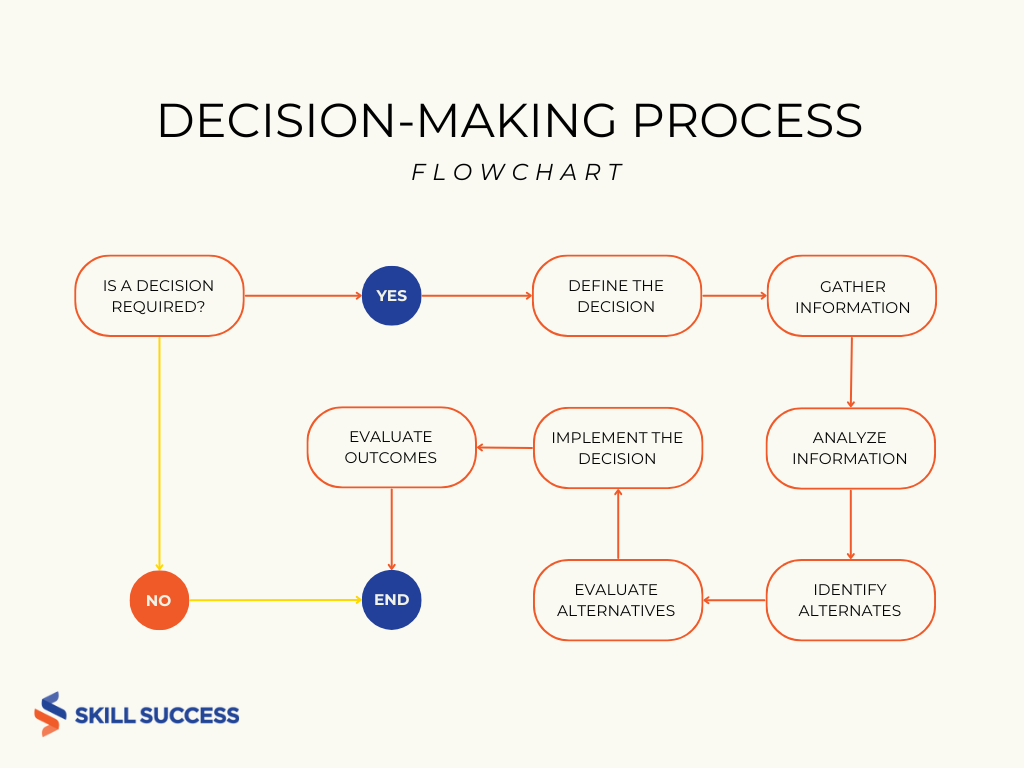The decision-making process is crucial in personal and professional settings, allowing individuals to make informed and thoughtful choices. By following a structured approach, you can ensure that each decision is well-supported, resulting in more effective outcomes. This guide will walk you through the key steps of the decision-making process, as illustrated in the flowchart below.
Step 1: Is a Decision Required?
Before diving into the complexities of decision-making, the first step is to assess whether a decision is necessary. Sometimes, the situation may resolve on its own, and no further action is needed. If the answer is no, the process ends here.
Key Considerations:
- Is the issue pressing enough to warrant a decision?
- Can the situation be handled without making any significant changes?
- Take a moment to evaluate the urgency before moving forward.
Step 2: Define the Decision
Once you determine that a decision is required, the next step is to clearly define the decision at hand. Understanding the issue and what is at stake will help you make a more targeted and effective choice.
Key Considerations:
- What is the specific problem or opportunity that requires a decision?
- What do you hope to achieve with this decision?
- Define your goals and ensure clarity before proceeding.
Step 3: Gather Information
After defining the decision, it is essential to gather relevant information. The more informed you are, the better equipped you will be to make the right choice.
Key Considerations:
- What data or insights do you need to make a well-informed decision?
- Where can you find this information?
- Ensure the information is reliable and relevant to the decision at hand.
Step 4: Analyze Information
Once you’ve gathered the necessary information, the next step is to analyze it carefully. Evaluate the facts, consider possible outcomes, and weigh the pros and cons of each option.
Key Considerations:
- What patterns or trends can you identify in the data?
- What are the potential risks or rewards associated with each option?
- Can you foresee any unintended consequences?

Step 5: Identify Alternatives
At this point, it’s important to consider alternatives. Decision-making often involves comparing multiple options before choosing the best course of action.
Key Considerations:
- Are there other solutions or approaches that could solve the problem?
- What are the strengths and weaknesses of each alternative?
- Consider any creative or unconventional options that may be viable.
Step 6: Evaluate Alternatives
After identifying potential alternatives, it’s time to evaluate each one thoroughly. This step helps you assess which alternative will most effectively address the problem and meet your goals.
Key Considerations:
- How does each alternative align with your objectives?
- What resources will be required for each option?
- Which alternative offers the best balance of benefits and costs?
Step 7: Implement the Decision
After choosing the best alternative, it's time to put your decision into action. Implementing the decision effectively is just as important as making the right choice.
Key Considerations:
- What steps need to be taken to implement the decision?
- Who needs to be involved in the process?
- Ensure clear communication and timelines to achieve the desired result.
Step 8: Evaluate Outcomes
Once the decision has been implemented, the final step is to evaluate the outcomes. This helps you determine whether the decision has been successful and what can be learned for future decisions.
Key Considerations:
- Did the decision achieve the desired results?
- What worked well, and what could have been improved?
- Take note of any lessons learned for future decision-making.

Conclusion
Following a structured decision-making process helps you make thoughtful and informed choices. By clearly defining the decision, gathering relevant information, and evaluating alternatives, you can make choices that lead to better outcomes. Implementing and assessing the decision allows you to learn from your experiences and continuously improve your decision-making skills.
To improve your decision-making even further, consider exploring relevant courses and resources that focus on critical thinking, problem-solving, and leadership.
Ready to refine your decision-making skills? Explore our courses to take your personal and professional growth to the next level!


